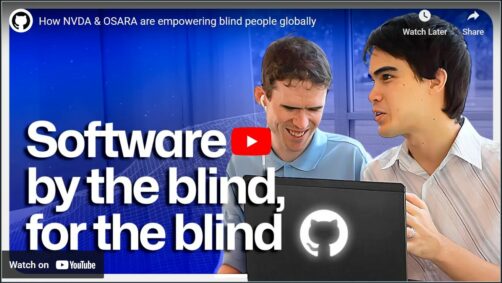Welcome to this 2024 Global Accessibility Awareness Day (GAAD) issue of In-Process! Let’s kick things off with a new Beta!
NVDA 2024.2 Beta 1
We are very pleased to share NVDA 2024.2 Beta 1. The first beta of the next version of NVDA is here and there are lots of exciting new features to test. Here are the highlights:
There is a new feature called sound split. This allows splitting NVDA sounds into one channel (e.g. left) while sounds from all other applications are directed to the other channel (e.g. right).
There are new commands for modifying the synth settings ring, allowing users to jump to the first or last setting, and to increase or decrease the current setting in larger steps. There are also new quick navigation commands, allowing users to bind gestures to quickly jump between: paragraph, vertically aligned paragraph, same style text, different style text, menu item, toggle button, progress bar, figure, and math formula.
There are many new braille features and bug fixes. A new braille mode called “display speech output” has been added. When active, the braille display shows exactly what NVDA speaks. Support was also added for the BrailleEdgeS2 and BrailleEdgeS3 displays. LibLouis was updated, adding new detailed (with capital letters indicated) Belarusian and Ukrainian Braille tables, a Lao table, and a Spanish table for reading Greek texts.
eSpeak was updated, adding new language Tigrinya.
There are many minor bug fixes for applications, such as Thunderbird, Adobe Reader, web browsers, Nudi and Geekbench.
Do read the full info and test it out from the NVDA 2024.2 Beta 1 release announcement.
GitHub documentary
To celebrate (GAAD), GitHub made a video. It features our founders, Mick and Jamie, and the successful open-source projects they have created. We all use or at least know NVDA, the free screen reader. Jamie also created OSARA, an accessibility extension for the Reaper music creation software. For those who may not be fully aware, GitHub is the platform we use to build our code and accept new submissions to NVDA. For most users, particularly those who don’t code, it is where you file bug reports or request new features. GitHub does all this and more for many, many projects. How many? As of January 2023, GitHub reported having over 100 million developers and more than 420 million repositories, including at least 28 million public repositories. It is the world’s largest source code host as of June 2023.
You can read the full article from GitHub which also contains links to the documentary. The video is available both audio-described, and non-AD.

New issue template
It is no secret that we value our code contributing community. They add new features and fix bugs throughout NVDA. But there are valuable contributions any user can make. Two of the most important are: Reporting when things aren’t working right and submitting new ideas. For NVDA, and many other projects, this is done by creating an issue on GitHub. When you create an issue for NVDA on GitHub, there used to be two options. You could file a “Bug Report” (Something isn’t working as it should) or a “Feature request” (something new in NVDA). In response to specific feedback from the community, we’ve got a new addition! Our Chief Technology Officer, Gerald, shared the following announcement in the user group:
We are pleased to announce the roll-out of a new issue template on GitHub for the NVDA project. This addition is part of our ongoing efforts to make contributing to NVDA more accessible and effective for everyone in our community.
What’s New?
The new template is designed to accommodate a wider range of issues, especially those that don’t fit the traditional bug report or feature request categories. We understand that the nature of contributions to NVDA can vary greatly, and this template aims to capture the unique aspects of each submission without the need for extensive customisation.
How to Use the New Template:
Accessing the Template: When creating a new issue on our GitHub site (https://github.com/nvaccess/nvda/issues/new/choose), you’ll find the option to select the “Special Case” template. This template is tailored for suggestions that don’t necessarily fall under existing categories.
Filling Out the Template: The template is structured to guide you through providing the essential information needed to understand and address your issue, but with greater flexibility than the more specific templates. For detailed instructions on filling out all of our issue templates, including the new one, please refer to our documentation: https://github.com/nvaccess/nvda/blob/master/projectDocs/issues/githubIssueTemplateExplanationAndExamples.md
When to Use This Template: Use this template when your issue or suggestion does not clearly fit into the other predefined categories. It’s perfect for unique problems, broad suggestions, or any feedback that requires a more open-ended format.
Why This Matters:
Your feedback is crucial to the continuous improvement of NVDA. By streamlining the reporting process and reducing the barriers to participation, we hope to encourage more community members to share their insights and ideas. Raising something as a GitHub issue is the best way to bring it to the attention of the NVDA development community and NV Access. To ensure your issues are seen and addressed, we strongly recommend submitting them to our GitHub platform after discussions in the user groups have concluded, the issue is clear, and the appropriate template can be filled out.
We appreciate the advice and discussions with our Advisory Group, which led to the development of this new template. We believe that these changes will make contributing simpler and more inclusive.
Please feel free to try out the new template and let us know your experience. Your feedback will help us refine and improve how we collaborate as a community.
Thank you for your continued support and dedication to improving NVDA.
That is all this week. Please try out NVDA 2024.2 Beta 1 and let us know what you think. Watch the inspiring documentary GitHub made, and we’ll be back with more near the end of the month.